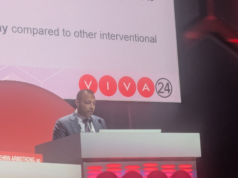
A recent study on iliac vein stenting following catheter-directed thrombolysis for deep vein thrombosis (DVT) has shown that technical and clinical success require high thrombus clearance rates, and stenting below the inguinal ligament does not have an adverse outcome in patency—but may predict post-thrombotic syndrome. Further, lead investigator Efthymios D Avgerinos (Division of Vascular Surgery, University of Pittsburgh Medical Center, Pittsburgh, USA) explained when presenting the data, the need to cover the contralateral iliac vein orifice may not be that frequent, and the risk of contralateral DVT upon stent jailing may not be necessarily related to the stent, but to underlying factors (e.g. hypercoagulability).
The data were presented by Avgerinos at the American Venous Forum (AVF; 20–23 February 2018, Tucson, USA).
Catheter directed thrombolysis (CDT) is increasingly used in acute iliofemoral deep vein thrombosis, despite the clinical benefit being controversial. “Still, technical aspects and our ability to predict failures are evolving”, Avgerinos stated, adding that stenting of uncovered lesions after thrombolysis is “a critical component of a clinically successful procedure”.
Speaking to Venous News, Avgerinos later explained, “Stenting is successful when extending from “good” to “good” vein, even if it needs to extend from below the inguinal ligament (sometimes into the femoral or deep femoral vein) and into the vena cava (when lesions are at the proximal common iliac vein). So, identifying the lesion is critical and appropriate imaging—ideally with intravascular ultrasound, alternatively through multiple angled projections—is essential. Accurate deployment can otherwise be challenging, particularly with the traditionally used Wallstent (Boston Scientific). The novel dedicated “venous”, stents which are now entering the US market, are accurate in deployment but it remains to be seen how they perform in the longer term.”
The objective of the study was to assess the outcomes and predictors of iliac vein stent failure and of contralateral iliac vein thrombosis after acute DVT thrombolysis and stenting. It was a retrospective study, with consecutive patients over the ten-year period 2007–2017. All patients had undergone thrombolysis and had received at least one stent. “We recorded demographics, risk factors, intraprocedural and postoperative data, and in particular we checked whether the stent was extending distally below the inguinal ligament and proximally into the vena cava jailing the contralateral iliac vein”, explained Avgerinos at AVF.
Endpoints included ipsilateral recurrence of DVT (stent patency), as well as contralateral leg DVT and post-thrombotic syndrome (PTS) defined by a Villalta score of five or greater. “Our analysis of the perioperative outcomes were analysed based on patient level, and long-term outcomes at limb level”, Avgerinos said, and a multivariate analysis was performed based on a range of variables including stent landing zones, DVT duration, and lysis completeness.
Out of 142 lysed patients, 73—including 12 bilateral DVTs—received at least one stent, resulting in a total of 77 stented limbs that consisted the study population. Most patients (72.6%) received a combination of catheter-directed and pharmacomechanical thrombolysis.
Immediate failure occurred in nine patients (12.3%), six of which had incomplete thrombolysis with clot residuals greater than 50%. Two major and six minor bleed complications occurred. During the follow-up, five more patients failed. Primary stent patency was 75.2%, and secondary patency 82.2% at 3 years. Stenting below the inguinal ligament was not found to have affected primary patency, but was associated with a higher rate of post-thrombotic syndrome (HR=6.68, p=.026). The single and most powerful predictor of stent failure was incomplete lysis defined as equal to or below 50% thrombus removal (HR=7.41, p=0.002).
At two years, post-thrombotic syndrome was at 12%, increasing to 14.4% by the five-year follow-up. According to the multivariate analysis, major predictors of post-thrombotic syndrome included incomplete lysis, stenting below the inguinal ligament and male gender (HR=7.09 [p=0.04], 6.68 [p=0.026] and 6.02 [p=0.041], respectively). Meanwhile, previous DVT and symptom duration did not have any predictive value.
“Regarding the low rate for post-thrombotic syndrome … we should probably not wonder that much—this is a study that included stented patients only. The CAVENT trial and the ATTRACT trial report higher post-thrombotic syndrome rates, but they had not actually stented a lot, only around 18% and 28% had a stent”, Avgerinos said at AVF.
Speaking with Venous News, Avgerinos added: “Liberal use of stents to cover an underlying chronic lesion or external compression (e.g. May Thurner syndrome) is critical to maintain patency and optimal clinical outcomes, and such stents are currently recommended by the American Venous Forum and CIRSE guidelines. The National Venous Registry demonstrated one-year patency that was significantly better in limbs treated with iliac stents (74%) than in limbs without stent placement (53%; p<.001). Still, the major randomised trials CaVenT and ATTRACT have demonstrated low stenting rates following thrombolysis, and this has been criticised as a limiting factor to show superiority of catheter interventions over anticoagulation alone. Our PTS rates (14% at 5 years) were much lower than those reported in CaVenT (43% at 5 years) and ATTRACT (47% at 2 years) and this may again relate to the fact that we are studying the “stented” population. In our previously published analysis of the entire lysed cohort (including the non-stented patients) PTS was 28% at 3 years. Stenting seems to make a difference…”
“This study focused on patients with acute iliofemoral DVT who received thrombolysis and stenting in a real world setting. We focused on this population as it gets increasingly evident that liberal stenting of uncovered lesions seems to be a critical component of a clinically successful thrombolysis procedure. The decision to stent though comes with some technical challenges: 1. identifying the lesion extent that needs to be covered is not always clear and stenting is not always accurate, 2. distal stenting below the inguinal ligament is still questioned as it raises concerns for restenosis , 3. proximal stenting into the vena cava might lead to contralateral DVT as the small stent interstices gradually become lined with neointima and the stent assumes the properties of a covered stent obstructing the contralateral iliac vein outflow. Our study identified the completeness of lysis as the dominant predictor of iliac vein stent patency and post-thrombotic syndrome prevention, while stent positioning below the inguinal ligament will not affect the outcomes. Stent placement across the iliocaval confluence is not independently associated with contralateral iliac DVT, as other intrinsic factors may come in play.”
Avgerinos further discussed with Venous News the impact of intravascular ultrasound (IVUS) on lysis success rates: “Complete >50% (ideally >90%) lysis, referred to as the open vein hypothesis, is an established surrogate predictors of long term patency and post-thrombotic syndrome. In broader terms, a poor lysis completion result mirrors a poor inflow or outflow state that will soon (typically within a month) lead to rethrombosis, thus every effort to clean as much thrombus as possible should be made and any residual thrombus should be considered chronic material that needs to be stented.”
“Venograms are a form of luminograms and veins have a high distensibility, making the identification and evaluation of residual thrombus or stenotic areas difficult. The decision of when to stent venographic findings after successful thrombolysis can be challenging and if no intravascular ultrasound is used, multiple angled projections and low threshold for stenting should be employed (still with questionable results). IVUS technology is the best way to accurately identify residual thrombus or stenosis and decide on more aggressive thrombolysis and eventually the stent landing zones.”









